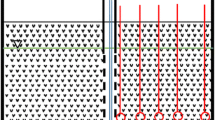Abstract
Lindane (γ-hexachlorocyclohexane, γ-HCH) is a recalcitrant and toxic organochlorine insecticide. Due to its non-selective production process and widespread use, HCH isomers and their degradation products have been detected frequently in soils and groundwater. An innovative technology using microbial produced Pd(0) nanoparticles, i.e. bio-Pd, was developed to treat groundwater containing a mixture of HCHs and chlorobenzenes. In a first step, the groundwater was de-ironized and most of the chlorobenzenes were removed in a biological trickling filter. The μg L−1 levels of HCHs and chlorobenzenes were removed in a second step by the bio-Pd-based technology. Therefore, a 200-L pilot scale reactor was developed with 100 mg L−1 bio-Pd encapsulated in alginate beads. Hydrogen gas was bubbled at the bottom of the reactor and served to charge the bio-Pd catalyst. The reactor influent contained 5.2 μg L−1 HCHs and 51.1 μg L−1 chlorobenzenes. During a test period of 10 days, 29% of the HCH isomers and 63% of the chlorobenzenes were removed applying a nominal hydraulic residence time of 4 h. These removal percentages could be increased to 75 and 68% by doubling the nominal hydraulic residence time to 8 h. This study demonstrated that biologically produced nanoparticles of Pd can be applied for the large-scale remediation of groundwater contaminated with HCHs.


Similar content being viewed by others
References
Alfonso DR, Cugini AV, Sholl DS (2003) Density functional theory studies of sulfur binding on Pd, Cu and Ag and their alloys. Surf Sci 546:12–26
Angeles-Wedler D, MacKenzie K, Kopinke FD (2008) Permanganate oxidation of sulfur compounds to prevent poisoning of Pd catalysts in water treatment processes. Environ Sci Technol 42:5734–5739
Angeles-Wedler D, Mackenzie K, Kopinke FD (2009) Sulphide-induced deactivation of Pd/Al2O3 as hydrodechlorination catalyst and its oxidative regeneration with permanganate. Appl Catal B 90:613–617
Davie MG, Cheng H, Hopkins GD, LeBron CA, Reinhard M (2008) Implementing Heterogeneous Catalytic Dechlorination Technology for Remediating TCE-Contaminated Groundwater. Environ Sci Technol 42:8908–8915
De Windt W, Aelterman P, Verstraete W (2005) Bioreductive deposition of palladium (0) nanoparticles on Shewanella oneidensis with catalytic activity towards reductive dechlorination of polychlorinated biphenyls. Environ Microbiol 7:314–325
Elliott DW, Lien HL, Zhang WX (2009) Degradation of lindane by zero-valent iron nanoparticles. J Environ Eng-ASCE 135:317–324
Gravil PA, Toulhoat H (1999) Hydrogen, sulphur and chlorine coadsorption on Pd(111): a theoretical study of poisoning and promotion. Surf Sci 430:176–191
Hadzi-Panzov J, Petrovski S, Alazarevski A (2001) Overview on the waste material from the former lindane plant in Skopje. 6th international HCH and pesticides forum. Poznan, Poland: Plant Protection Institute. Poznan, Poland, pp 129–134
Hennebel T, De Gusseme B, Boon N, Verstraete W (2009a) Biogenic metals in advanced water treatment. Trends Biotechnol 27:90–98
Hennebel T, Simoen H, De Windt W, Verloo M, Boon N, Verstraete W (2009b) Biocatalytic dechlorination of trichloroethylene with bio-Pd in a pilot-scale membrane reactor. Biotechnol Bioeng 102:995–1002
Hennebel T, Verhagen P, Simoen H, De Gusseme B, Vlaeminck SE, Boon N, Verstraete W (2009c) Remediation of trichloroethylene by bio-precipitated and encapsulated palladium nanoparticles in a fixed bed reactor. Chemosphere 76:1221–1225
Jagnow G, Haider K, Ellwardt PC (1977) Anaerobic dechlorination and degradation of hexachlorocyclohexane isomers by anaerobic and facultative anaerobic bacteria. Arch Microbiol 115:285–292
Joo SH, Zhao D (2008) Destruction of lindane and atrazine using stabilized iron nanoparticles under aerobic and anaerobic conditions: effects of catalyst and stabilizer. Chemosphere 70:418–425
Kutz FW, Wood PH, Bottimore DP (1991) Organochlorine pesticides and polychlorinated biphenyls in human adipose tissue. Rev Environ Contam Toxicol 120:1–82
Li BG, Cao J, Liu WX, Shen WR, Wang XJ, Tao S (2006) Geostatistical analysis and kriging of hexachlorocyclohexane residues in topsoil from Tianjin, China. Environ Pollut 142:567–575
Lloyd JR, Yong P, Macaskie LE (1998) Enzymatic recovery of elemental palladium by using sulfate-reducing bacteria. Appl Environ Microbiol 64:4607–4609
Mertens B, Boon N, Verstraete W (2006) Slow-release inoculation allows sustained biodegradation of gamma-hexachlorocyclohexane. Appl Environ Microbiol 72:622–627
Mertens B, Blothe C, Windey K, De Windt W, Verstraete W (2007) Biocatalytic dechlorination of lindane by nano-scale particles of Pd(0) deposited on Shewanella oneidensis. Chemosphere 66:99–105
Ricking M, Schwarzbauer J (2008) HCH residues in point-source contaminated samples of the Teltow Canal in Berlin, Germany. Environ Chem Lett 6:83–89
Sambrook J, Russell DW (2001) Molecular cloning: a laboratory manual. Cold Spring Harbor Laboratory Press, Cold Spring Harbor, NY
Schuth C, Reinhard M (1998) Hydrodechlorination and hydrogenation of aromatic compounds over palladium on alumina in hydrogen-saturated water. Appl Catal B 18:215–221
Schuth C, Disser S, Schuth F, Reinhard M (2000) Tailoring catalysts for hydrodechlorinating chlorinated hydrocarbon contaminants in groundwater. Appl Catal B 28:147–152
Tu CM (1976) Utilization and degradation of lindane by soil-microorganisms. Arch Microbiol 108:259–263
Zinovyev SS, Shinkova NA, Perosa A, Tundo P (2004) Dechlorination of lindane in the multiphase catalytic reduction system with Pd/C, Pt/C and Raney-Ni. Appl Catal B 47:27–36
Acknowledgments
This work was funded by Bauer Umwelt GmbH and Pion technologies. Tom Hennebel was supported by the Fund of Scientific Research-Flanders (Fonds voor Wetenschappelijk Onderzoek (FWO) Vlaanderen) (7741-02). The authors thank Gie Spaepen for the many critical, practical and helpful suggestions and Bart De Gusseme, Simon De Corte and Jessica Benner for critically reading the manuscript.
Author information
Authors and Affiliations
Corresponding author
Rights and permissions
About this article
Cite this article
Hennebel, T., Simoen, H., Verhagen, P. et al. Biocatalytic dechlorination of hexachlorocyclohexane by immobilized bio-Pd in a pilot scale fluidized bed reactor. Environ Chem Lett 9, 417–422 (2011). https://doi.org/10.1007/s10311-010-0295-x
Received:
Accepted:
Published:
Issue Date:
DOI: https://doi.org/10.1007/s10311-010-0295-x




